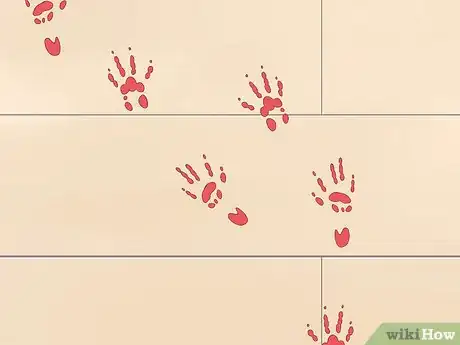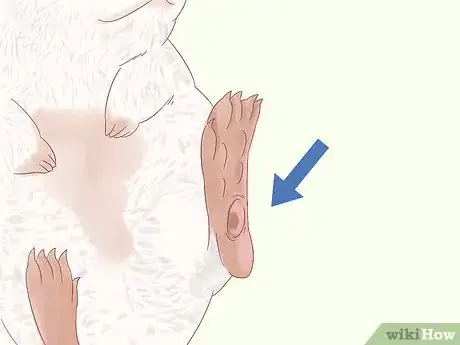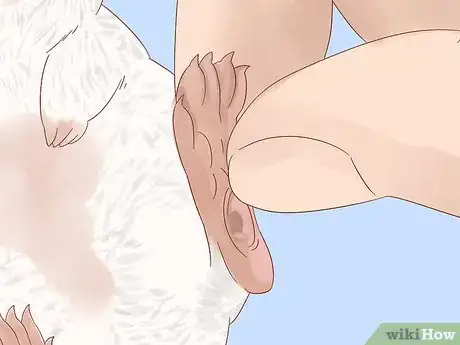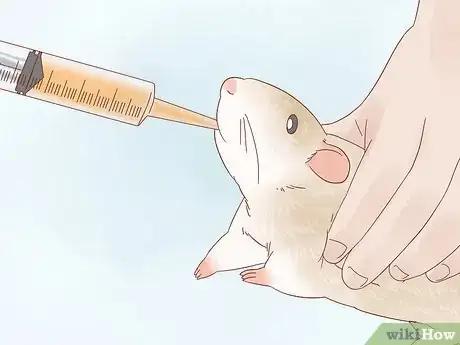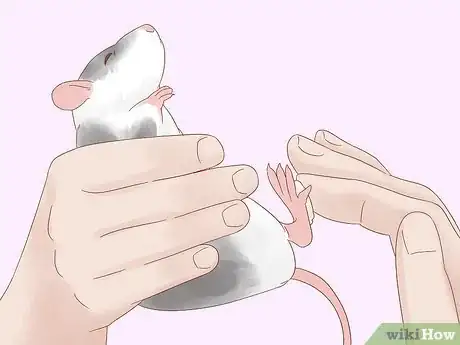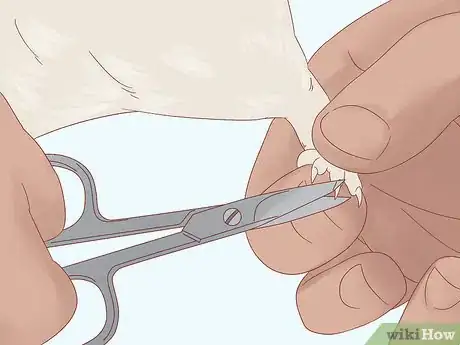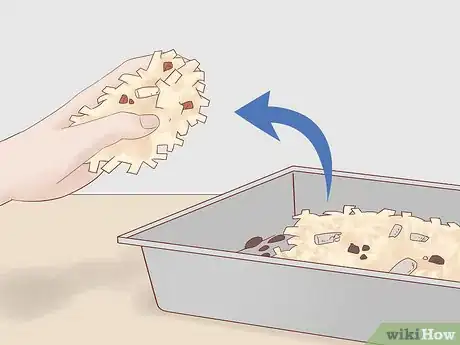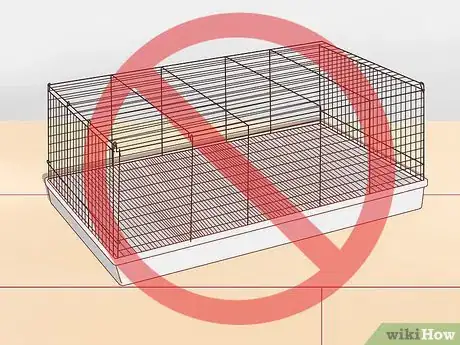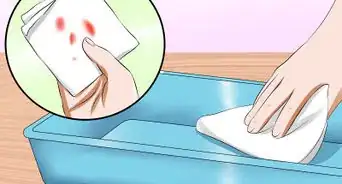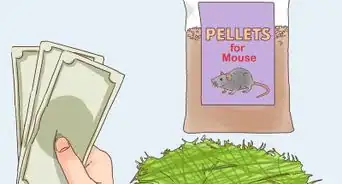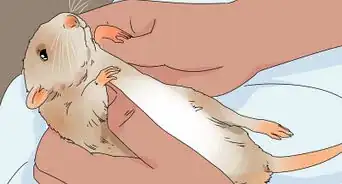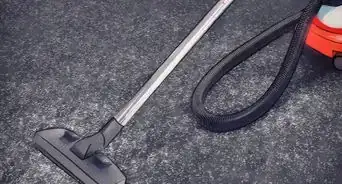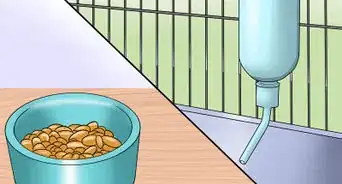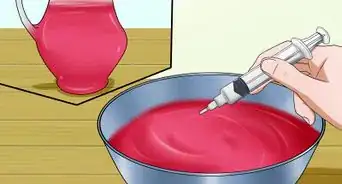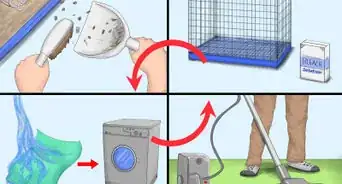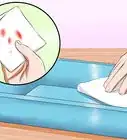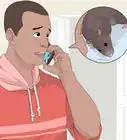This article was co-authored by Pippa Elliott, MRCVS. Dr. Elliott, BVMS, MRCVS is a veterinarian with over 30 years of experience in veterinary surgery and companion animal practice. She graduated from the University of Glasgow in 1987 with a degree in veterinary medicine and surgery. She has worked at the same animal clinic in her hometown for over 20 years.
This article has been viewed 26,170 times.
Bumblefoot is a condition that usually develops in the feet of rodents through a staph infection. Possible causes include rough or dirty cage and bedding areas, obesity, or a genetic predisposition.[1] Fortunately, bumblefoot is treatable by a medical professional if spotted quickly enough. However, if it's left untreated, bumblefoot can become septic and treatment-resistant.
Steps
Detecting Symptoms of Bumblefoot
-
1Watch for lethargic behavior in your rat. If your rat is not climbing or running around as often as usual or has lost its appetite, it may be due to the presence of painful sores on its feet.[2]
-
2See if your rat is excessively licking its feet. If your rat is licking its feet more often than usual, it may be because of a wound.
- Just because a rat is licking itself doesn't mean there is something wrong with it. Rats tend to lick themselves in order to self-clean.
Advertisement -
3Look for red footprints on the cage floor. If your rat is bleeding from its feet, it's possible that an already-infected wound has reopened, or that you need to take action to prevent an infection from beginning.
-
4Look for red bumps or abscesses on your rat's feet. This is a tell-tale sign that your rat has developed bumblefoot.
- If you discover that your rat has bumblefoot, you should take it to a vet as soon as possible.
-
5Do not attempt to drain an abscess on your own. Doing so could give your rat sepsis, a deadly blood infection that can result from an improperly-handled wound.[3]
Treating Bumblefoot
-
1Bring your rat to a vet for a proper diagnosis. Your local veterinarian may confirm your at-home diagnosis and address the wound. Topical and/or oral medications may be prescribed to help your rat recover.
-
2Administer oral medication to your rat, if prescribed. Have your rat consume the antibiotics through a syringe or pipette to ensure it is taking the full dosage.
- Mix your rat's oral medication with some diluted apple juice if you see that your rat doesn't like the taste of the medication.
- Use the full amount prescribed by your vet. Failure to do so may result in your rat relapsing from a stronger version of the bacteria.
-
3Rub any topical medication directly on the rat's wound. Be sure that your rat is keeping the medication on by checking the area regularly.
-
4Cover the bottom of your rat's cage with soft bedding. Your rat needs a soft walking surface in order to recover. The bottom should be a smooth surface, then add at least 3 inches (7.6 cm) of bedding. Change out the bedding as soon as it becomes soiled.
- A cut up yoga mat makes a great base for the bottom of the cage.
-
5Trim your rat's nails. This will help prevent your rat from reopening the wound by scratching at it. Regular trimming may also aid in averting future lacerations from developing.[4]
- Consider buying specialty nail scissors that are sold in most pet stores. They offer better grip than human nail clippers, which is important, as you'll have to hold your rat in one hand while cutting the nails with the other.[5]
- Cut the clear part of the nail only. Cutting into the pink vein (aka the quick) will cause your rat to bleed. Have cornflour on hand to stem the bleeding in case you accidentally cut the vein.[6]
Preventing Future Bumblefoot Outbreaks
-
1Clean your rat's cage on a regular basis. Remove any excrement or spilled food in your rat's cage as often as you can. These are likely to carry the staph bacteria, which could spread to a potential open sore.[7]
-
2Modify or replace your rat's wire-floored cage. Wire-floored cages can be harmful to your rat's feet.[8] If you have such a cage, you may wish to cover the bottom of it with a durable, flat material, or purchase an entirely new cage.
-
3Provide soft bedding for your rat. A soft walking surface helps prevent bumblefoot. Create a flat, smooth surface on the bottom of the cage. Then, add at least 3 inches (7.6 cm) of bedding to the floor of the cage. As soon as your rat soils the bedding, change out the dirty bedding.
- Even a smooth cage bottom can rub your rat's foot, so you need to use bedding.
-
4Maintain a healthy diet for your rat. Offer your rat sugary or high-fat foods sparingly; obese rats are at more of a risk of contracting bumblefoot.
- Feeding your rat food high in amino acids, fatty acids, vitamins and minerals is suggested.[9]
- Make sure your rat always has access to fresh drinking water.
Expert Q&A
-
QuestionCan rats get bumblefoot?
 Pippa Elliott, MRCVSDr. Elliott, BVMS, MRCVS is a veterinarian with over 30 years of experience in veterinary surgery and companion animal practice. She graduated from the University of Glasgow in 1987 with a degree in veterinary medicine and surgery. She has worked at the same animal clinic in her hometown for over 20 years.
Pippa Elliott, MRCVSDr. Elliott, BVMS, MRCVS is a veterinarian with over 30 years of experience in veterinary surgery and companion animal practice. She graduated from the University of Glasgow in 1987 with a degree in veterinary medicine and surgery. She has worked at the same animal clinic in her hometown for over 20 years.
Veterinarian Yes, rats can get bumblefoot although, happily, it is not as common as in rabbits. This is because rats are lighter and distribute their body weight more evenly, which means their hocks don't rub on the ground quite so much.
Yes, rats can get bumblefoot although, happily, it is not as common as in rabbits. This is because rats are lighter and distribute their body weight more evenly, which means their hocks don't rub on the ground quite so much. -
QuestionHow do you treat bumblefoot at home?
 Pippa Elliott, MRCVSDr. Elliott, BVMS, MRCVS is a veterinarian with over 30 years of experience in veterinary surgery and companion animal practice. She graduated from the University of Glasgow in 1987 with a degree in veterinary medicine and surgery. She has worked at the same animal clinic in her hometown for over 20 years.
Pippa Elliott, MRCVSDr. Elliott, BVMS, MRCVS is a veterinarian with over 30 years of experience in veterinary surgery and companion animal practice. She graduated from the University of Glasgow in 1987 with a degree in veterinary medicine and surgery. She has worked at the same animal clinic in her hometown for over 20 years.
Veterinarian The first and most important thing is to make sure the rat has plenty of deep, dry, soft bedding as continued contact with a dirty substrate makes everything else pointless. Then bathe the sore area with weak salt water (use 1 tsp of salt to 1 pint of cooled, previously boiled water) twice a day and dry the skin afterward. If the rat is off-color or there is a purulent discharge from the skin, then it's essential to see a vet.
The first and most important thing is to make sure the rat has plenty of deep, dry, soft bedding as continued contact with a dirty substrate makes everything else pointless. Then bathe the sore area with weak salt water (use 1 tsp of salt to 1 pint of cooled, previously boiled water) twice a day and dry the skin afterward. If the rat is off-color or there is a purulent discharge from the skin, then it's essential to see a vet. -
QuestionWhat is bumblefoot in chinchillas?
 Pippa Elliott, MRCVSDr. Elliott, BVMS, MRCVS is a veterinarian with over 30 years of experience in veterinary surgery and companion animal practice. She graduated from the University of Glasgow in 1987 with a degree in veterinary medicine and surgery. She has worked at the same animal clinic in her hometown for over 20 years.
Pippa Elliott, MRCVSDr. Elliott, BVMS, MRCVS is a veterinarian with over 30 years of experience in veterinary surgery and companion animal practice. She graduated from the University of Glasgow in 1987 with a degree in veterinary medicine and surgery. She has worked at the same animal clinic in her hometown for over 20 years.
Veterinarian This is a similar condition to that in rabbits and rats. It starts out as sore hocks with red inflamed skin and if the skin surface becomes ulcerated or broken, it then becomes infected.
This is a similar condition to that in rabbits and rats. It starts out as sore hocks with red inflamed skin and if the skin surface becomes ulcerated or broken, it then becomes infected.
References
- ↑ https://www.thesprucepets.com/bumblefoot-in-rats-1238512
- ↑ https://www.thesprucepets.com/bumblefoot-in-rats-1238512
- ↑ https://www.petmd.com/exotic/conditions/skin/c_ex_rt_staphylococcal_infection#
- ↑ https://www.petmd.com/exotic/conditions/skin/c_ex_rt_staphylococcal_infection#
- ↑ https://pethelpful.com/rodents/How-to-Trim-Your-Pet-Rats-Nails
- ↑ http://ratclub.org/ratcare_grooming.htm
- ↑ https://www.thesprucepets.com/bumblefoot-in-rats-1238512
- ↑ https://www.petmd.com/exotic/conditions/skin/c_ex_rt_staphylococcal_infection#
- ↑ https://www.rspca.org.uk/adviceandwelfare/pets/rodents/rats/diet


